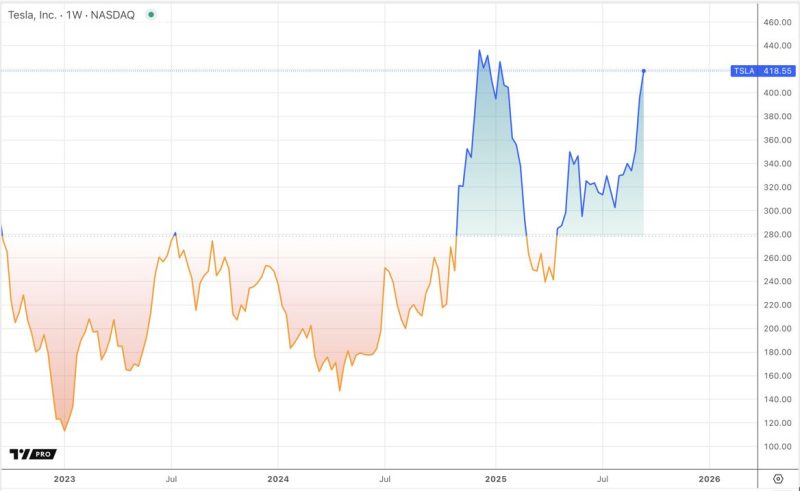Tesla continues to be in the spotlight for investors and analysts, although the reasons for this have been far from clear in recent months. On the one hand, the company is showing a decline in the production of electric vehicles, and its founder, Elon Musk, remains under close attention not only in the business sphere but also in the political one, which has created reputational risks and put additional pressure on shares. On the other hand, Musk remains the main factor for investor trust in Tesla, and the company’s management is doing its best to emphasize his unique role in the brand’s future.
Since the spring low, Tesla stocks have grown about 85%, which has made a significant contribution to the growth of the S&P 500 index in recent months, especially given Tesla’s substantial capitalization.

Against this background, Tesla has proposed a new ten-year compensation plan for Musk. According to the terms, more than 423 million shares can be transferred to him, increasing his ownership stake to 25%. The key indicator for receiving remuneration will be the growth of Tesla’s market capitalization from about $1 trillion to $8 trillion. For shareholders, this means that the CEO’s financial incentives are directly tied to the increase in the company’s value. At the same time, Musk had previously threatened to leave Tesla if his voice in management was not strengthened, and the new plan could be seen as a way to ease tensions.
The publication of a new compensation plan for Elon Musk may also affect investor expectations. If the market perceives it as a factor of long-term sustainability and an incentive for capitalization growth, demand for the stock will increase, supporting the indices. At the same time, skepticism about the realistic nature of the goal of raising Tesla’s value to $8 trillion can limit the positive effect. Thus, investors’ reaction to the company’s plans and Musk’s personal steps will be of direct importance not only for Tesla itself, but also for the dynamics of the entire market.
However, Musk’s remuneration has been controversial in recent years. Simply recall that a court previously blocked the payment of a $56 billion package to him, and the company was forced to compensate Musk $29 billion. The new plan will also be put to a vote at the annual shareholders’ meeting, scheduled to occur before the year’s end.
Meanwhile, Tesla stocks continue to fluctuate amid the current heightened volatility. In April, they reached their lowest levels since the beginning of the year after Donald Trump’s statements about the possible introduction of new import duties, and Q1 was the worst for the company since 2022.
At the same time, the stock has grown significantly since the spring lows, which was facilitated by both the general recovery of interest in the technology sector and the news about Musk’s purchase of Tesla securities for almost $1 billion. The fact that Musk is willing to invest his own funds in the company has become a signal to some investors that there is long-term confidence in the business prospects.
Now Tesla is betting on new directions, such as robotaxi and its humanoid robot, Optimus. Rising crude oil prices continue to make electric vehicles more attractive, strengthening the long-term business case for Tesla, while the company is trying to convince investors that these segments will be crucial for its future.
For Musk, the new compensation plan is not only a matter of personal gain, but also a tool to link his own future with Tesla’s ambitious goals. For investors, it remains the main indicator that the company is still a major player, even if current performance in the automotive business is far from ideal.
